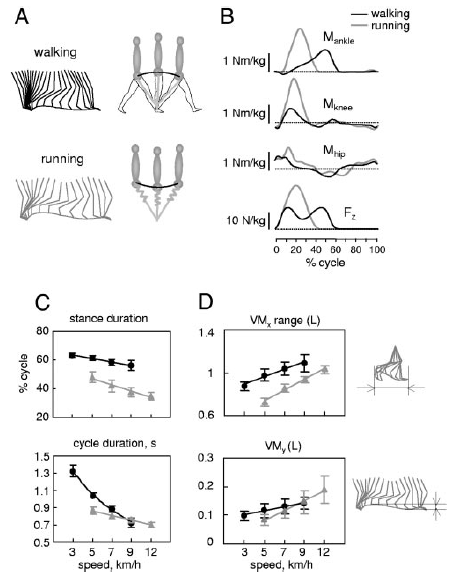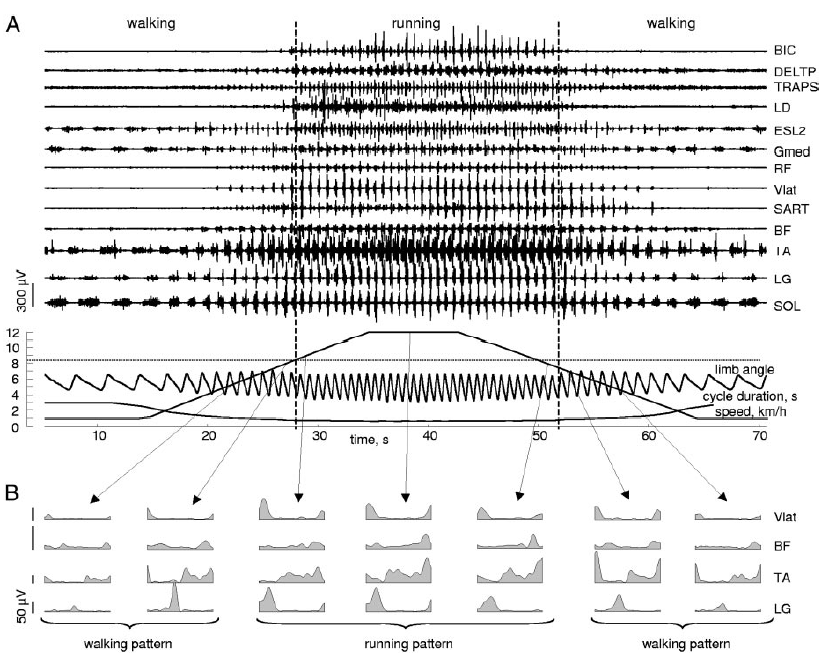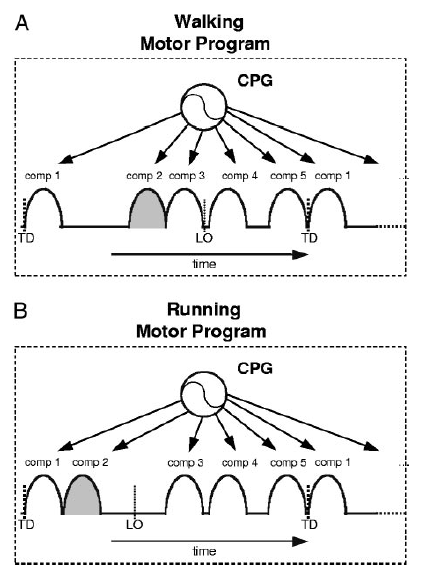Before I was retired, I used to take the bus to work.
- One day, when I am walking toward the bus stop, I saw my bus already pulling up to my bus stop, and I noticed, in a moment later, that I was off and running toward it.
- Later on, I realized in that brief moment, I had made an abrupt and radical switch from walking to running.
Well what happened? To answer that question, let’s allow Lacquaniti’s group provide the answer from their utterly fascinating study on walking versus running (Cappellini et al 2006). They describe the general characteristics of walking and running in their Fig. 1 shown below (notice that walking is solid black lines and running is fainter grey lines):

FIG. 1. General characteristics of walking and running. A: schematic representation of walking by vaulting (inverted pendulum) and running by a “bouncing” gait (leg spring-loaded behavior during stance). B: ankle, knee, and hip moments of force and vertical ground reaction force (normalized to the subject’s weight) of the right leg during overground walking (5.4 km/h) and running (9.4 km/h) in 1 representative subject. C: relative stance duration and cycle duration (± SD) in walking and running. D: foot (fifth metatarsophalangeal joint, VM) trajectory characteristics (mean ± SD, normalized to the limb length L): horizontal excursion of the VM marker [relative to greater trochanter (GT)] and vertical VM displacements (in the laboratory reference frame).
First, they wrote this concerning the general characteristics of walking and running:
“Running and walking gaits are usually adopted for different speeds of locomotion, with a preferred transition occurring at ≈7 km/h for most human subjects (Nilsson et al. 1985). Some major differences between the two gaits are illustrated in Fig. 1A. During walking, the leg tends to behave like a rigid strut, and the joints remain relatively extended throughout the stance phase (Lee and Farley 1998). In contrast, during running, the major leg joints undergo substantial flexion and extension during stance as the leg behaves in a more spring-like manner.
“… We examined both gaits at 5, 7, and 9 km/h and walking alone at 3 km/h and running alone at 12 km/h. Although increases in locomotion speed in both gaits were accomplished by increasing both the cadence and stride length, the duration of the stance phase was always >50% of the gait cycle for walking and <50% for running (Fig. 1C). This difference corresponds to a change from a double support phase during walking to a single support during running, which is then accompanied by a greater ground reaction force occurring shortly after foot contact at the beginning of the cycle (Fig. 1B).”
Next Cappellini et al. (2006) describe the changes in muscle activity patterns in their Fig. 2 shown below:

FIG. 2. Slow changes in treadmill belt speed (ramp speed condition) in 1 representative subject. A: electromyographic (EMG) activity, instantaneous treadmill belt speed, limb angle, and gait cycle duration. Limb angle was defined as GT-LM elevation angle [the angle between the greater trochanter (GT)-lateral malleoulus (LM) segment projected on the sagittal plane and the vertical]. B: EMG activity of selected muscles [gastrocnemius lateralis (LG), tibialis anterior (TA), semitendinosus (ST), and vastus lateralis (Vlat)] computed for single cycles before and after the transition cycle. Vertical dashed lines denote the transition from walking and running (defined by the presence/absence of the double support phase). The transition typically occurred at the higher speed during gait acceleration as opposed to gait deceleration…. Note that except for a few muscles like BIC ([biceps] associated with an abrupt change in the forearm elevation during running), there is no obvious distinction in the intensity of muscle activation at the transition from walking to running. However, there are differences at the transition in the pattern of muscle activation. [Emphasis added]
They wrote this about the muscle activation patterns:
“The overall effect of speed on the average EMG activity was consistent with that reported in the literature…. The intensity of distal leg activity is more similar across speeds, whereas the intensity of proximal leg and trunk activity increases much more with speed. Except for a few muscles like BIC [biceps], there is no obvious distinction in the intensity of muscle activation at the transition from walking to running (dotted vertical lines in Fig. 2A). However, there are differences in the patterns of activation at the transition, particularly in the distal leg muscles. The peak of LG activation shifts to an earlier phase in the cycle. Instead the changes in Vlat and ST activation are less obvious (Fig. 2B). The single cycle records at the gait transition points show that the difference in the activation timing of the calf muscles between walking and running occurs abruptly within a single step cycle (Fig. 2B). Some high-intensity muscle activation prior to the walk-to-run transition (see LG activity) is consistent with the idea that the activation of major leg muscles might act as a trigger for gait transition and explain why locomotion at nonpreferred speeds requires excessive muscle activation (Prilutsky and Gregor 2001).
“The posterior calf muscles tend to function as one unit. During walking, the anterior muscles (TA) become active prior to lift-off and remain active throughout the swing phase and into the first 10% of the next cycle. The posterior calf muscles (MG, LG, SOL, PERL) are all active at ̴40% of the cycle when the anterior muscles are relatively silent. With running, this pattern reverses so that the anterior muscles increase their activity during the mid part of the cycle, and the posterior muscles are active instead around the time of foot contact. This, in fact, is the most marked change in muscle coordination we observed in the transition between walking and running.” [Emphasis added]
Key points:
- Transition is from walking, a form of locomotion using an out-of-phase coordination like the body vaulting over stiff leg, to running, using in-phase coordination like bouncing on a pogo stick.
- Transitition does occur in one gait cycle.
- The transitions occurs when the muscles of Pattern/Component 2, the posterior calf muscles like the lateral gastrocnemius, in the next stride shift to align closer to foot contact rather than later in mid-stance to lift-off.
- Shorten time to lift-off
They suggest that change in patterning may occur as shown in Fig. 8 from Cappellini et al (2006):

FIG. 8. Hypothetical motor programs for walking (A) and running (B) in terms of the characteristic timing of muscle activations. In both programs, 4 activation components (1, 3, 4, and 5) occur relative to the touch-down (TD) phase of the cycle and component 2 occurs relative to the lift-off (LO) phase, at about 20% of the cycle preceding LO. As 1 gait mode is switched to the other, the timing of LO relative to TD changes along with the relative timing of component 2 with respect to the other 4 components
Notice how the time from foot contact to lift-off has dramatically shortened. they suggest that there are five distinct motor programs each consisting of one of the patterns. I wonder if there are only two; one that is composed of patterns 1, 3, 4, and 5 and the other that is only pattern 2.
Exercise: please try walking slowly and just after lift-off of your dominant leg, intentionally elevate your dominant leg, pull your toes up, push off hard with you non-dominant leg, and touch down more forward on your foot than the heel. Then continue on with your gait doing the same actions with the non-dominant foot.
How does this exercise mimic the transition from walking to running? What is the sequence of muscles used? What is differenct in the timing of the muscle patterns?
Take home: An abrupt one-stride change happens with the transition to running that only involved muscle pattern 2, the muscles of the posterior lower leg, and utilized a phase change of those muscle activations from mid-stance and lift-off to near foot contact.
Next: How did the regulation of locomotor pattern selection change, and what changed in the spinal pattern generators, in the brain stem and basal ganglia locomotor control regions, in the prefrontal-insular network, and in the motor cortex networks?
References
Cappellini G, Ivanenko YP, Poppele RE, Lacquaniti F. (2006) Motor patterns in human walking and running. J Neuroscience 95: 3426-3437.
Lee CR, Farley CT. (1998) Determinants of the center of mass trajectory in human walking and running. J Exp Biol 201: 2935-2944.
Nilsson J, Thorstensson A, Halbertsma J. (1985) Changes in leg movements and muscle activity with speed of locomotion and mode of progression in humans. Acta Physiol Scand 123: 457-475.
Pilutsky BI, Gregor RJ. (2001) Swing- and support-related muscle actions differentialy trigger human walk-run and run-walk transitions. J Exp Biol 204: 2277-2287.
[subscribe2]